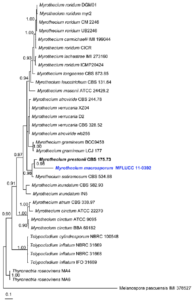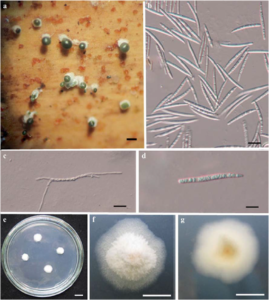Myrothecium macrosporum D.Q. Dai & K.D. Hyde.
Index Fungorum number: IF550939, Facesoffungi number: FoF00451, Fig. 2
Etymology: In reference to the big conidia.
Holotype: MFLU 14–0823
Saprobic on decaying bamboo culms, forming dark green, glistening, slimy drops on the centre of white mycelial sporodochia. Mycelium partly immersed on the substrate, partly superficial, composed of septate, branched, hyaline, smooth hyphae, 400–600μm diam. Conidiophores sporodochial, macronematous, cylindrical, brown to dark brown, septate, branched, straight, smooth, single conidiophores 200–500× 4–5μm. Conidiogenous cells phialidic, integrated or discrete, cylindrical, pale brown, smooth, straight. Conidia 25–35×2– 3μm (x=29.6×2.7μm, n=20), cylindrical, narrow at the apex, truncate at the base, straight to slightly curved, flexuous, 0–3- septate, hyaline, smooth-walled, with guttulate cells.
Culture characters: Conidia germinating on PDA within 24 h and germ tubes developing from both ends. Colonies growing slowly on PDA, reaching 4 mm in 2 week at 28 °C, circular, with irregular edge, hyaline from forward and reverse view. Mycelium superficial to immersed in/on media, with branched, septate, smooth hyphae.
Material examined: THAILAND, Chiang Rai, Mae Sae Village, on dead culm of bamboo (Bambusae), 14 May 2011, Dong-Qin Dai, DDQ 00019 (MFLU 14–0823, holotype), isotype in KUN, under the code of HKAS 83938), ex-type living culture at MFLUCC 11–0392. GenBank ITS: KP744448; LSU: KP744491.
Notes: Tulloch (1972) monographed the genus Myrothecium, redescribed eight species and added two new species and three new combinations. The genus is typified by M. inundatum Tode ex S.F. Gray (Preston 1948). Presently, there are 79 records of Myrothecium in Index Fungorum (2015), most of them are saprobes and some are pathogens (Yamazaki et al. 2014). The species concept within the genus Myrothecium is rather broad and sometimes controversial, with species having a saprobic, pathogenic or hyperparasitic habitat, sessile or stalked sporodochia to synnematous conidiomata and smooth-walled or striated conidia (Ellis 1971, 1976). The genus awaits revision. Our new species differs from other species of Myrothecium by the larger size of its conidia (more than 20μm long). Myrothecium macrosporum is somewhat closely related to M. prestonii and M. setiramosum in the phylogenetic analysis (Fig. 1). However, M. prestonii was isolated from soil and M. setiramosum from leaves of Eugenia glabrata.

Fig. 1 Phylogram generated from Bayesian analysis based on ITS sequence data. Bayesian posterior probabilities (PP) greater than 0.90 are indicated above or below the nodes. The extypes (reference strains) are in bold, the new isolates are in blue. The tree is rooted with Melanospora pascuensis IMI 378527.

Fig. 2 Myrothecium macrosporum (holotype) a Fruiting bodies on bamboo b, d Conidia c Germinating conidium e–g Cultures on PDA. Scale bars: a=500μm, b–d=20μm, e=25 mm, f, g=5 mm.
